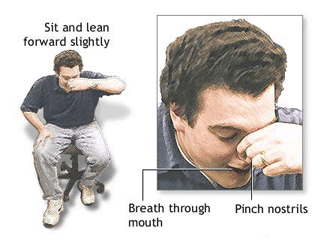First Aid – Nosebleed
A human nose is rich with small fragile blood vessels which are susceptible to damage. A nosebleed may be caused by a fall, a strike to the nose, or even from breathing excessively dry air.
If the nosebleed is not a symptom of a more serious injury, it is rarely dangerous and can usually be stopped by applying continuous pressure.

- Do NOT tilt the victim’s head backward.
- Have the victim sit or stand upright to slow down the flow of blood.
- Loosen any tight clothing around the victim’s neck.
- If possible, have the victim spit out excess saliva – swallowing may disturb the clot and cause nausea.
- Pinch the nostrils shut and press the tip of the nose against the bones of the face.
- Maintain pressure for 5 to 10 minutes.
- Once the bleeding has stopped, the victim should avoid blowing his nose or otherwise straining himself for at least an hour.